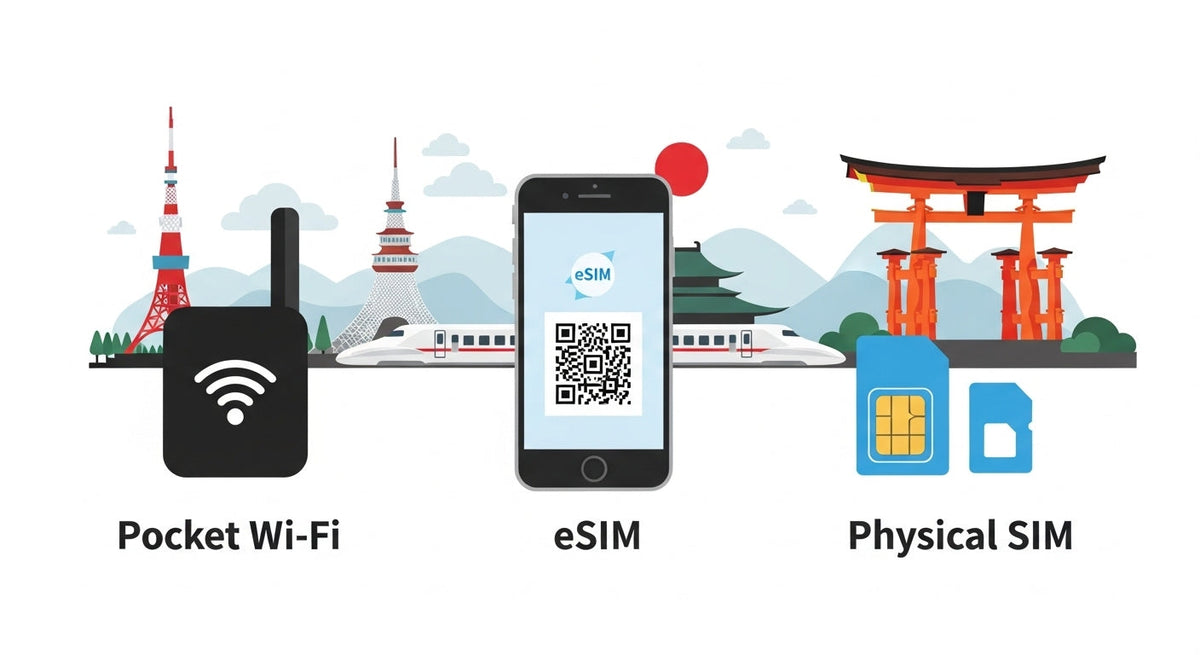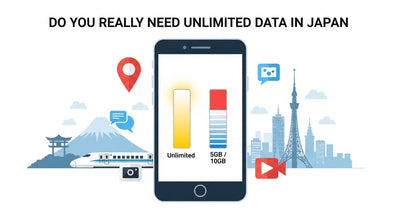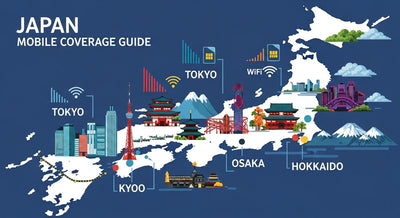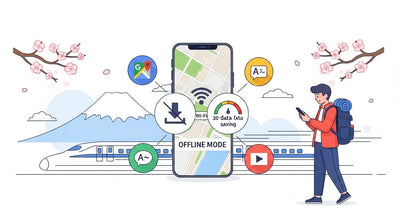Overview
Landing in Japan is exciting, but staying connected can be stressful. Between booking trains, navigating crowded cities, translating menus, and sharing travel photos, mobile data is essential.
Travelers today face three main options: Pocket Wi-Fi rentals, eSIMs, and physical SIM cards. Each has strengths and weaknesses. The best choice depends on your trip length, group size, budget, and how comfortable you are with tech.
This guide provides:
- A side-by-side comparison table
- A decision flowchart for quick answers
- Scenario-based recommendations for solo travelers, couples, and groups
- Links to setup guides, compatibility checkers, and troubleshooting tips
Why This Matters for Short-Stay Visitors
Visitors staying 2–7 days often face unique challenges:
- Time pressure: No one wants to spend an hour at the airport counter troubleshooting Wi-Fi.
- Group coordination: Couples or small groups need flexible sharing options.
- Cost sensitivity: Paying ¥8,000 for a device you use only four days feels wasteful.
- Fear of loss: Pocket Wi-Fi rentals often charge steep penalties if you misplace the device.
That’s why comparing all three connectivity options before your trip can save money, frustration, and unnecessary stress.
Comparison Table
| Factor | Pocket Wi-Fi | eSIM | Physical SIM |
|---|---|---|---|
| Initial setup | Pick up at airport/store | Scan QR, instant | Swap SIM, reboot |
| Total cost (typical) | Medium–high | Low–medium | Low–medium |
| Convenience | Extra device to carry | No extra device | No extra device |
| Group sharing | Hotspot OK, battery drains | Phone hotspot OK | Phone hotspot OK |
| Loss risk | Rental loss fees | None (profile only) | Small SIM loss risk |
| Activate before arrival | No | Yes | Generally no |
| Support & recovery | Counter hours only | Online support, quick | Store visit may be needed |
Tip: Save this chart to your phone before flying—it’s a handy reminder at the airport counter.
The Decision Flow
🗺️ How to choose in under 30 seconds
-
Do you need to share with 3+ people and multiple laptops daily?
→ Yes = Pocket Wi-Fi candidate.
→ No → Continue.
-
Do you want instant setup without airport pickup?
→ Yes = eSIM.
→ No = Physical SIM.
This quick flow covers 80% of use cases. For the remaining 20%, read the scenarios below.
Option 1: Pocket Wi-Fi
Pocket Wi-Fi has been the classic solution for Japan travelers for over a decade. Companies like Ninja Wi-Fi and Global Advanced Communications rent small routers you carry with you.
Pros:
- Can connect 5–10 devices at once, useful for families or groups with laptops.
- Stable speed since the router is optimized for data.
- Airport pickup and return counters are convenient.
Cons:
- Bulky: another gadget to charge and carry all day.
- Loss risk: replacement fees can exceed ¥20,000 (~$130).
- Battery stress: if it dies, everyone loses internet.
Best for: Groups of 3–6 traveling together, especially if multiple members need laptops online at the same time.
Option 2: eSIM
The new favorite for short-stay travelers. eSIMs are digital SIM profiles you download directly to your phone—no plastic, no pickup, no waiting in line.
Pros:
- Instant setup: Activate before you fly, land in Japan already connected.
- No extra device: Works inside your phone.
- Flexible plans: 3-day, 5-day, or data-by-GB.
- No loss risk: Nothing physical to misplace.
- Hotspot sharing still works.
Cons:
- Device compatibility: Only works on newer iPhones, Pixels, Samsung, and some others. (Check your device here).
- First-time confusion: Terms like “data roaming” and “APN” can be scary if you’ve never done it.
- Voice calls: Most eSIM data plans don’t include a Japanese phone number.
Best for: Solo travelers, couples, or small groups who value convenience and low cost.
Option 3: Physical SIM
Still offered at airport counters and convenience stores, physical SIM cards involve swapping your regular SIM with a Japanese one.
Pros:
- Works even if your phone doesn’t support eSIM.
- Reliable, since it uses the same networks as eSIM.
- Often low-cost for short plans.
Cons:
- SIM swapping: You must remove your existing SIM, keep it safe, and insert it again after the trip.
- No pre-activation: Must wait until arrival in Japan.
- Store support: If something breaks, you often need to visit a shop.
Best for: Travelers with older phones, or those who prefer something tangible.
Scenarios & Recommendations
-
Solo traveler, light data use (Google Maps, messaging, occasional Instagram)
→ eSIM small–medium plan (e.g., 3–5GB for 5 days).
-
Couple sharing a hotspot, city hopping (Tokyo–Kyoto–Osaka)
→ eSIM medium–large plan (e.g., 10GB shared via phone hotspot).
-
Group of 4–6 with laptops and streaming needs
→ Pocket Wi-Fi rental (but assign one person as the “charger” captain).
-
Business traveler needing a Japanese phone number
→ Physical SIM with voice option or use app-based calling like Skype/LINE Out.
Cost Breakdown
For a 5-day trip:
- Pocket Wi-Fi: ~¥4,000–¥6,000 ($25–40), plus deposit or loss penalty.
-
eSIM: ~¥1,800–¥3,500 ($12–23) depending on data size.
- Physical SIM: ~¥2,000–¥3,500 ($13–23).
💡 eSIM usually wins on cost per traveler, especially if each person buys their own plan.
Risks and Recovery
- Pocket Wi-Fi: If you lose it, recovery is impossible—penalty fees apply.
- eSIM: Can usually be re-issued quickly via online support.
- Physical SIM: If lost, you must purchase a new one in person.
Support Experience
- Pocket Wi-Fi: Support only during counter hours, often long queues.
- eSIM: Most providers offer 24/7 online chat or email.
- Physical SIM: Must find a physical store for help.
Make Your Japan Trip: Save Smart. Connect Fast.
The real strength of JP-SIM.com is not only its simplicity and convenience, but also its outstanding affordability compared to other options.
No more waiting in long airport lines for a SIM card or carrying a heavy pocket Wi-Fi. With JP-SIM, you can purchase online before departure, scan the QR code, and get connected the moment you land in Japan.
JP-SIM is significantly cheaper than roaming and many competitor services, while still offering flexible plans that match your travel days and data needs. Powered by Japan’s major carrier networks, it provides reliable high-speed coverage across the country—from Tokyo and Kyoto to Hokkaido and rural areas. And with 24/7 multilingual support, even first-time visitors can travel with confidence.



